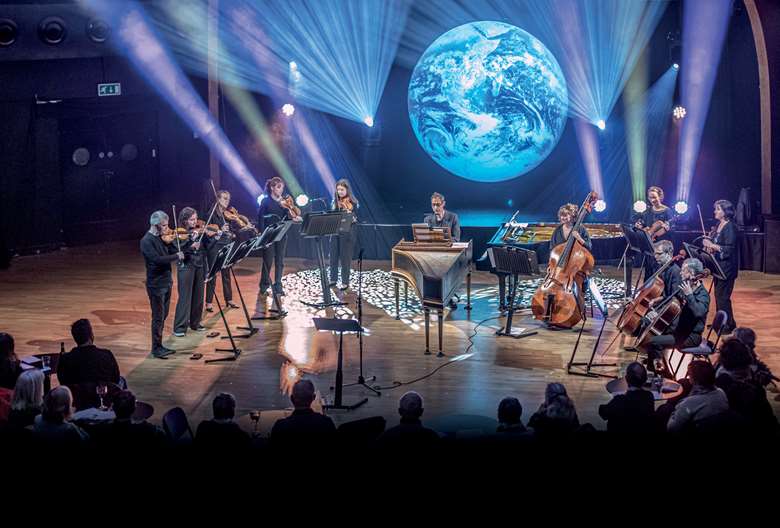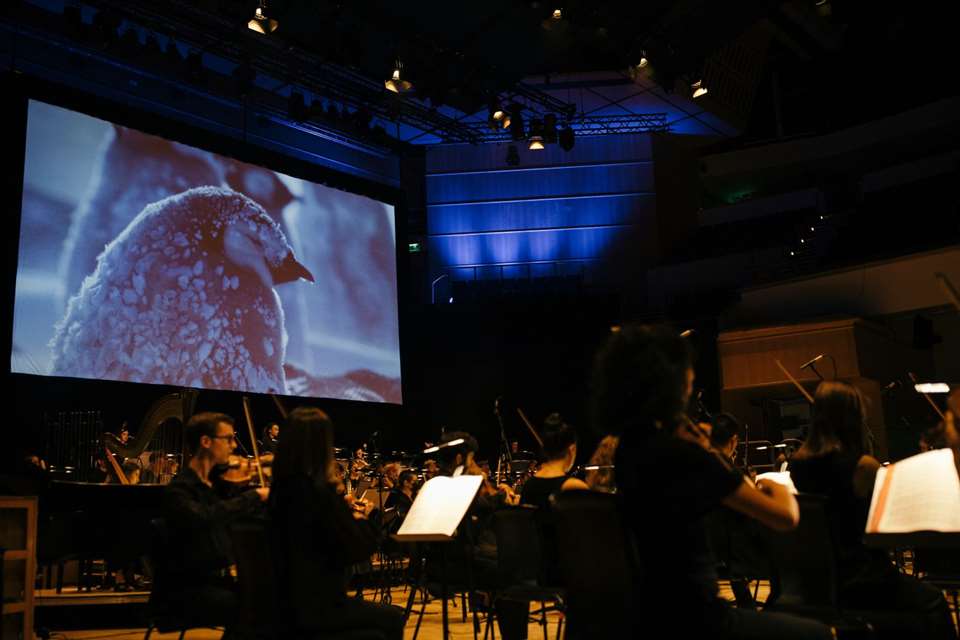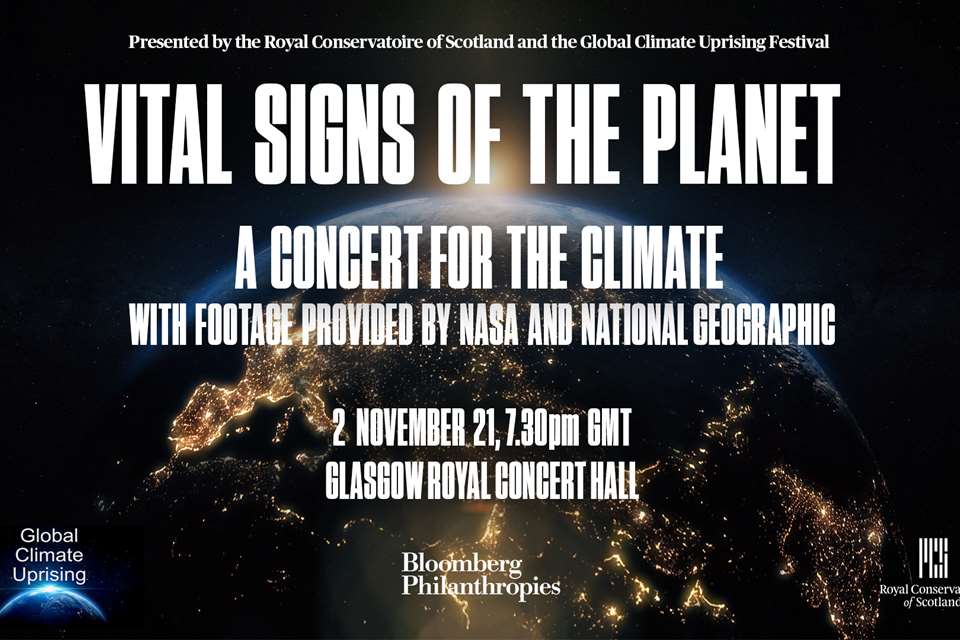Climate-conscious music-making
Claire Jackson
Friday, March 1, 2024
Young people have a powerful role to play in tackling the climate crisis. Claire Jackson explores how music can be used to raise awareness and inspire action.

The wipers are on the fastest setting, whizzing across my car windscreen. Water is streaming down the road, collecting in enormous puddles at a rate I have never experienced. Hazard lights flash ahead; traffic jams. A tree has fallen down, hitting a car and narrowly missing the driver. We inch away, holding our breath. Further ahead, a ford has formed. Some of the bigger vehicles pass with ease, but the majority have to turn around. Some time later, not too far away from my destination, I realise that my VW Polo cannot cope with another deep immersion. I abandon the car and wade home.
Flash floods are increasing in the UK – in 2020, according to the British Red Cross, England received 141% of its average February rainfall over less than two weeks. Floods are among the symptoms of climate change. Each summer threatens to be hotter than the one that came before it; the Environment Agency says that extreme weather events are four times more likely to happen now than in 1970. At macro level, the figures are suitably terrifying: The Guardian reported that the Greenland ice cap has recently been observed to be losing an average of 30m tonnes of ice an hour – 20% more than previously thought – as the average global temperature has increased by just over 1° Celsius (2° Fahrenheit) since 1880; two-thirds of the warming has occurred since 1975. And, while my soggy journey was unpleasant, it was nothing compared with the recent floods across the world, from Cairns to Cumbria, or the forest fires, or any of the other disasters that can be linked with the climate crisis.
Musical depictions
The perilous situation is reflected in music. Simmy Singh's Lament For The Earth was among the pieces commissioned for the City of Birmingham Symphony Orchestra's centenary in 2020 and features on the 2023 album Sounds New (NMC DL 3054). The vocal line swoops, bird-like, over the strings, calling out for reconnection with the natural world. Alastair Penman's Do You Hear Me? from the same year is more urgent; saxophone motifs loop while spliced vocals warn ‘Now we don't have a future’. More ominously, John Luther Adams's epic Become Ocean (2013), scored for large orchestra divided into three spatially separate groups, evokes the possibility of a future world covered in water, while Sarah Kirkland Snider's 2018 Mass for the Endangered is a six-movement requiem for the nearly gone. (The latter has been recorded by Gallicantus and Gabriel Crouch via Nonesuch 7559792005; it receives its UK premiere at the Three Choirs Festival on 29 July.)
Educational resources
The pieces mentioned can be included in lessons for more advanced students, but climate change is also covered in specific resources aimed at primary and Early Years. Alfred Music offers a range of sheet music, such as Sally Albrecht and Jay Althouse's songbook It's Easy Being Green and Robert Sheldon's concert band piece Power the Earth, while Music for Schools has a one-act musical for ages 6–9, called Save Our Planet!, as well as a book of environmental education songs for ages 7–11, called Go for Green. Sing Up provides a range of options, including the songs Our Earth and Eco Warriors.
Midlands-based Orchestra of the Swan's new project Earthcycle, a nature-inspired concert programme and album dedicated to Vivaldi's The Four Seasons, includes 12 lesson plans created in partnership with author, artist and teacher Felicity Robinson. ‘We use the music as a springboard to discuss how humans have had an impact on the planet, through four videos linked to each season’, explains Robinson, who has also created a relevant free ebook: ‘A’ is for Art in STEAM! Early Years Outdoors (see her website felicityknappstudio.org). ‘It's about reconnecting with nature and making some simple observations about seasonal changes.’
The videos feature Orchestra of the Swan (OotS) musicians as well as images of landscapes and animals. The text is simple and engaging, but doesn't shy away from the harsh realities. ‘In many places there is not enough rain where there used to be enough water … because of this there are too many people struggling to survive’, says the narrator. ‘Wildlife is suffering because of the way you have farmed my land’, explains the voice of earth.
‘There is scope to use Vivaldi's The Four Seasons as a cross-curricular tool’, explains Robinson, ‘that can be really useful in a primary setting’. Before each performance, the voices say in unison: ‘In this video, we look at how the seasons are changing, and what you can do to slow down climate change’. These suggestions include sourcing food locally to reduce travel miles, leaving messy spaces in gardens at school and keeping a fresh water supply for wildlife. The video concludes with the earth's plea: ‘Do remember that you can help me to help you to enjoy this world and keep it safe for generations to come’.
Imagining a different world
These are lessons that can potentially stay with you for life. When I was at school, the song From the Tiny Ant – recently resurrected via social media thanks to music teacher James Partridge through his ‘school assembly bangers’ – used to cause great concern. The lyrics ‘From the tiny ant, to the elephant, from the snake to the kangaroo, care for them it's up to you – no-one else will care for them, it's up to you’ partly inspired an early membership to the WWF (I fondly recall the cute faux Filofax), staunch vegetarianism and an annoying habit of producing ‘save the planet’ posters (audience unidentified). It was relatively benign, but many students – including young children – are now known to be suffering from climate anxiety.
The despair – along with denial – provoked by the climate crisis is addressed in Houses Slide, Laura Bowler's opera-cum-oratorio, which uses real-life testimonials gathered by librettist Cordelia Lynn with support from climate anxiety psychotherapist Ro Randall. Collective responsibility is anchored by the experience of a nameless individual whose own response to climate change develops through different movements (Epiphany, Immersion, Depression and Resolution). As part of Earthcycle, OotS commissioned a podcast with Guardian writer and producer Madeleine Finlay (in partnership with the Stratford Literary Festival), who addresses this topic in a positive way that is suitable for young children – with recommended tasks including imagining the world you want to see in 2100 and attempting to go vegetarian or vegan for a day each week.
Industry response
These types of activity are being played out within the music industry more broadly. Many venues have signed up to the Theatre Green Book, a set of guidelines on how to make shows and arts organisations more sustainable. Opera companies are committing to sourcing new productions from existing materials and sharing sets. The newly opened Bristol Beacon aims to become the UK's first net zero concert hall by 2030, while between 2012 and 2020 Glyndebourne says that its wind turbine generated the equivalent of 105% of the electricity used by the company.
Instrument makers are responding, too. Dawkes has collaborated with Pisoni to launch V-Pads for saxophone, one of the first non-leather options for saxophonists. ‘As we see a new generation of players voice their concern on the trade's reliance on animals, particularly the leather from calves used in many pads, we recognise that we need to push the boundaries’, notes Dawkes.
Meanwhile, as we learn more about deforestation, the wood used for instruments including pianos, guitars and clarinets is coming under closer scrutiny. The Convention on International Trade in Endangered Species of Wild Fauna and Flora (CITES) has limited the use of rosewood, previously a popular choice for guitar makers. Alternatives like ebony and mahogany are also at risk, so makers are turning to maple. Pernambuco (known as brazilwood) has been used for bow-making since the 18th century due to its rare ability to hold a fixed curve. But pernambuco is now an endangered species and Brazil's Atlantic Forest, the tree's native and only habitat, has shrunk to around 12% of its original size. In 2018 over 20,000 violin bows made with illegally-logged wood from the black market were seized. It's likely that, without interference, the pernambuco could be wiped out within a decade. Trees of Music is currently supporting a project to plant 50,000 pernambuco trees, as well as raise awareness.
Taken at face value, it may seem as if music is detached from the climate crisis. But the notes and instruments we play – and the venues and artists we support – are an important part of a wider eco-system that faces serious threat.







